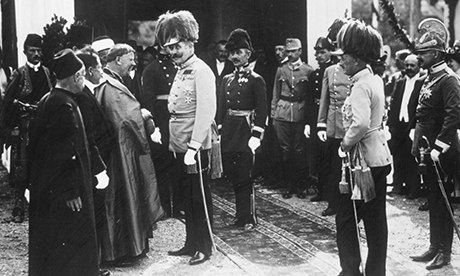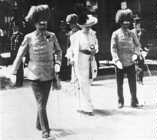 |
| Archduke Franz Ferdinand of Austria-Hungary, being greeted by dignitaries in Sarajevo, June 28, 1914 |
June 28, 1914 was an ordinary Sunday in the village of Bila,
just outside the eastern wall of the city of Ternopil. The villagers attended church and ate
dinner at home. They spent spring and summer afternoons outdoors, visiting with
friends and enjoying the summer weather. Nobody had any idea how everyone’s lives
would change because of what happened that Sunday morning in Sarajevo, Bosnia-Herzegovina.
My great-aunt, Katherine Rychly was 10 years old in
1914. Her father, Sylvester, was in Minneapolis, Minnesota, working at a sugar
company in order to save enough money to bring his family to the United
States. Katherine’s older sister
Anna was newly married and living in Minneapolis. Katherine's other older sister, my
grandmother, Paranka (Pauline), had left Bila a few days earlier, and sailed from
Bremen, Germany, on June 23, arriving in New York on July 1, 1914. Katherine, Anna and Paranka wouldn’t
see each other again until 1922.
 |
| Map of the Austria-Hungary Empire, showing Bosnia - Herzegovina and the city of Sarajevo |
Sarajevo, Bosnia, was located in a province of the Austria-Hungary
Empire, added in 1908, after being occupied by the Austrians since 1878. The province had a mixed
population of Serbs, Croats, Muslims and other ethnic groups. The annexation of Bosnia-Herzegovina by
Austria-Hungary was unpopular with its people. I have heard from family stories
that my paternal grandfather, John Nyznyk, was a soldier in the Austrian army,
stationed in Bosnia-Herzegovina, and he said that there were a lot of problems there.
After the Balkan war of 1912-1913, the neighboring country of Serbia
gained territory and power, and growing Serbian nationalism encouraged the
Serbs to do something about the status of Bosnia and Herzegovina.
June 28 is an important day to the Serbians, St Vitus’s Day,
the day when, in 1389, the Ottoman Turks destroyed the Serbian Army on the Field
of Blackbirds—today known as Kosovo, and ended the Serbian Empire. The Serbian lands and people became
part of the Ottoman Empire. The
visit of the Archduke, Franz Ferdinand to Sarajevo on June 28 was considered an
insult to the Serbs. Austrian
authorities were warned that the Archduke’s visit wasn’t a good idea, but
nobody took these threats seriously.
Seven young Serbian men volunteered to assassinate the Archduke and his
wife. They were members of a secret Serbian nationalist society, The Black Hand.
 |
| Archduke Franz Ferdinand arriving in Sarajevo on the morning of June 28, 1914 |
On Sunday morning, June 28, the Archduke and his wife, the
Duchess Sophie, arrived at the Sarajevo train station. There was a six car
motorcade waiting, full of Austrian and local dignitaries. Their first destination was the Sarajevo
City Hall, with other stops scheduled later.
The Archduke and the Duchess were in the second car, open so
the crowds could see them, along with the Governor of Bosnia and another
person. There was no security along the route, normally soldiers line the
streets when important dignitaries such as the Archduke visited. The chosen
route, Appel Quay runs along the Miljacka River. Two cells of Serbian terrorists were stationed along the
Quay. To insure its success, seven men were assigned to the plot. Each one had small bomb strapped to his
waist, a revolver and a packet of cyanide in his pocket.
The first assassin lost his nerve and did not throw his
bomb. As the second assassin detonated his bomb, it made a noise
similar to a blown tire, which alerted people in the motorcade. The bomb was thrown just as the driver
stepped on the gas. The Archduke
batted the bomb away, and it exploded under the third car, injuring several
people. The second assassin swallowed the cyanide and jumped over the wall and into
the river. His suicide attempt was
unsuccessful, and he was easily captured.
The motorcade was stopped so the wounded could be attended
to, and the proceeded to the Town Hall.
The third, fourth and fifth assassins lost their confidence
and did nothing. |
| The Archduke and Duchess minutes before the assassination |
The Motorcade arrived at the Town Hall, the planned
speeches continued after the Archduke expressed his unhappiness with the
“welcome” he received. It was
decided to cancel the rest of the day’s activities, however, the Archduke
wanted to visit the wounded at the hospital. Nobody thought to tell the drivers of the changed plans, so
when the parties arrived at the cars, the procession went ahead with the original route. Someone in the Archduke’s
party shouted that they were driving in the wrong direction, so the cars
stopped. Since the Archduke’s car
did not have a reverse gear, the car had to be pushed backwards to Franz Joseph Street.
The sixth assassin, Gavrilo Princip, saw that the car stopped
and ran toward it. He untied the
bomb, but decided to use his revolver.
The first bullet hit the Duchess in the stomach. The second shot hit the Archduke in the
neck. Both died quickly, by the
time the car arrived at the hospital, both were dead. It was 11 o’clock in the morning.
 |
| Newspaper depiction of the assassination. Duchess Sophie was shot in the stomach, the Archduke was shot in the neck. |
The next day, newspaper headlines around the world told the
story, but nobody as any idea how far reaching the consequences of the
assassination would be. Many people
remembered for years, exactly what they were doing when they heard the news of the assassination,
the effect was similar to how people felt when they heard about the Attack on
Pearl Harbor, the Assassination of President Kennedy or 9/11.
Article in the June 28, 2014 edition of The Chicago Tribune about the Assassination and its worldwide impact.
Article from The New York Times, June 28, 2014 present day division in Sarajevo and Bosnia
Read "1914, The Year That Changed Everything" eeroots blog post from January 2014 for more background information.
Article from The New York Times, June 28, 2014 present day division in Sarajevo and Bosnia
Read "1914, The Year That Changed Everything" eeroots blog post from January 2014 for more background information.
 |
| Headline on the front page of the Philadelphia, PA. newspaper, The North American |



No comments:
Post a Comment